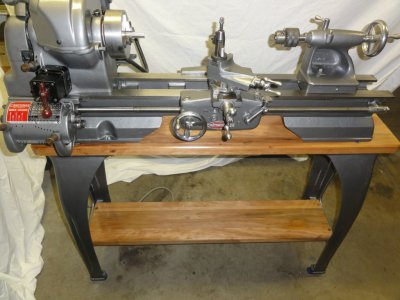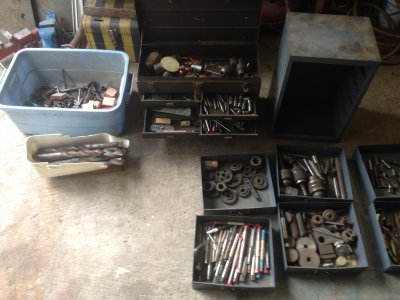My first lathe: a craftsman 101.07403. Restoration process and progress...
Wednesday I followed a craigslist ad to a small warehouse near me. I traded an old compound bow, some shotgun shells, and $50 for a craftsman 10107403 lathe.
I've been wanting a lathe to make small custom parts for my airguns. I had planned on buying a HF 7x12. But when the opportunity to pick up this piece of american history, I couldn't pass it up. I know its not the best example of its era and I feel I understand the inherent shortcomings of this piece of equipment, but I have old tools that do right by me when I give them a bit of love and attention.
I got quite a bit of tooling, parts, and accessories. Some of which I plan to sell to fund the upgrades I want.The rest of it I think is all serviceable and will help me learn the craft.
I'm in the process of restoring it. I'm not a machinist, I have no Idea what I'm doing. And as such I've decided to video the whole disassembly process as well as the assembly process. Mostly so I can remember what goes where. But I'll probably upload it to youtube for others to laugh at.
I've found about all the basic info that others come here asking for, manuals, parts diagrams, etc...What I don't have i experience or knowledge of how this whole thing and all its doo-dads are supposed to work.
So my hope is this...I'll document as best as my feeble brain will allow, the whole process of tear down and assembly, (not cleaning and paint cuz that's boring). And in turn you guys will laugh at me when I do something stupid and maybe impart a bit of your experience to me along the way. Also, if you could help me assess what parts of value to a beginner and what parts may have value to help fund my first steps, I'd really be brimming with gratitude.
I'm a carpenter by trade, and I'm in the process of converting my old brewery into a machine room. I'm barely financially solvent, and none too bright...but I hope my experience will benefit others and maybe provoke some sympathy from those here that have "been here, done this."
I thank you for entertaining me...I'll upload some pics here in the next few hours and show you what I'm starting with and how far I've gotten in the last few days.
Thanks for welcoming me to the community in advance and I appreciate your advice and pity...
:victory:
Joshua
Wednesday I followed a craigslist ad to a small warehouse near me. I traded an old compound bow, some shotgun shells, and $50 for a craftsman 10107403 lathe.
I've been wanting a lathe to make small custom parts for my airguns. I had planned on buying a HF 7x12. But when the opportunity to pick up this piece of american history, I couldn't pass it up. I know its not the best example of its era and I feel I understand the inherent shortcomings of this piece of equipment, but I have old tools that do right by me when I give them a bit of love and attention.
I got quite a bit of tooling, parts, and accessories. Some of which I plan to sell to fund the upgrades I want.The rest of it I think is all serviceable and will help me learn the craft.
I'm in the process of restoring it. I'm not a machinist, I have no Idea what I'm doing. And as such I've decided to video the whole disassembly process as well as the assembly process. Mostly so I can remember what goes where. But I'll probably upload it to youtube for others to laugh at.
I've found about all the basic info that others come here asking for, manuals, parts diagrams, etc...What I don't have i experience or knowledge of how this whole thing and all its doo-dads are supposed to work.
So my hope is this...I'll document as best as my feeble brain will allow, the whole process of tear down and assembly, (not cleaning and paint cuz that's boring). And in turn you guys will laugh at me when I do something stupid and maybe impart a bit of your experience to me along the way. Also, if you could help me assess what parts of value to a beginner and what parts may have value to help fund my first steps, I'd really be brimming with gratitude.
I'm a carpenter by trade, and I'm in the process of converting my old brewery into a machine room. I'm barely financially solvent, and none too bright...but I hope my experience will benefit others and maybe provoke some sympathy from those here that have "been here, done this."
I thank you for entertaining me...I'll upload some pics here in the next few hours and show you what I'm starting with and how far I've gotten in the last few days.
Thanks for welcoming me to the community in advance and I appreciate your advice and pity...
:victory:
Joshua
Last edited:



![IMG_0693[1].JPG IMG_0693[1].JPG](https://www.hobby-machinist.com/data/attachments/33/33811-6c01f20b9bd6b24eb21d501768c15ba1.jpg)
